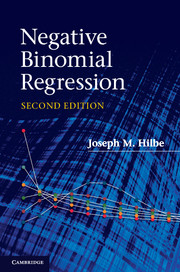Book contents
- Frontmatter
- Contents
- Preface to the second edition
- 1 Introduction
- 2 The concept of risk
- 3 Overview of count response models
- 4 Methods of estimation
- 5 Assessment of count models
- 6 Poisson regression
- 7 Overdispersion
- 8 Negative binomial regression
- 9 Negative binomial regression: modeling
- 10 Alternative variance parameterizations
- 11 Problems with zero counts
- 12 Censored and truncated count models
- 13 Handling endogeneity and latent class models
- 14 Count panel models
- 15 Bayesian negative binomial models
- Appendix A Constructing and interpreting interaction terms
- Appendix B Data sets, commands, functions
- References and further reading
- Index
6 - Poisson regression
Published online by Cambridge University Press: 05 June 2012
- Frontmatter
- Contents
- Preface to the second edition
- 1 Introduction
- 2 The concept of risk
- 3 Overview of count response models
- 4 Methods of estimation
- 5 Assessment of count models
- 6 Poisson regression
- 7 Overdispersion
- 8 Negative binomial regression
- 9 Negative binomial regression: modeling
- 10 Alternative variance parameterizations
- 11 Problems with zero counts
- 12 Censored and truncated count models
- 13 Handling endogeneity and latent class models
- 14 Count panel models
- 15 Bayesian negative binomial models
- Appendix A Constructing and interpreting interaction terms
- Appendix B Data sets, commands, functions
- References and further reading
- Index
Summary
Poisson regression is the standard or base count response regression model. We have seen in previous discussions that other count models deal with data that violate the assumptions carried by the Poisson model. Since the model does play such a pivotal role in count response modeling, we begin with an examination of its derivation and structure, as well as a discussion of how it can be parameterized to model counts per unit time or area. Also discussed are the different interpretations of Poisson coefficients, marginal effects and discrete change, and graphics such as effect plots. We also show how to construct synthetic Poisson models in both Stata and R, but which can be developed in other languages using the same logic as described here.
Derivation of the Poisson model
Poisson regression, based on the Poisson probability distribution, is the fundamental method used for modeling count response data. As previously mentioned, however, the Poisson model can also be construed as a subset of the NB2 model. Poisson is an NB2 model with a heterogeneity parameter value of zero. This relationship is discussed in detail in Chapter 8.
In this section we discuss the derivation of the Poisson regression model. First, in Section 6.1.1 we demonstrate how the Poisson probability distribution can be derived from the binomial distribution. In Section 6.1.2, given the Poisson distribution first displayed in equation 3.1, we derive the Poisson regression model.
Information
- Type
- Chapter
- Information
- Negative Binomial Regression , pp. 77 - 140Publisher: Cambridge University PressPrint publication year: 2011
